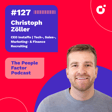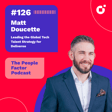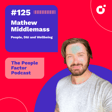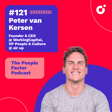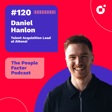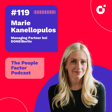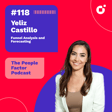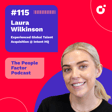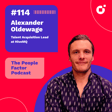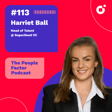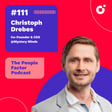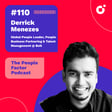Introduction to Funnel Analysis and Its Importance
00:00:07
Speaker
Katrin, I really looked forward to this episode. and We met someone, I think, early last year um at events. Then um you were also part of my executive dinners. I always really, really enjoyed the conversations.
00:00:21
Speaker
And now we are here today talking about how to master funnel analysis and how to use it as a recruiter um and what you can expect from it.
00:00:32
Speaker
um And um maybe we start first with a short introduction about yourself before diving into the topic.
Catherine's Background and Experience
00:00:38
Speaker
Wonderful. Yeah, super excited. And thank you, Thomas, for having me. um Hello, I'm Catherine.
00:00:44
Speaker
I'm a global head of talent and I spent the last 16 years as talent an expert in high growth tech environments, both scale up and big tech. I'm a global citizen. lived five different countries across across Europe and Asia in the last 15 years.
00:01:00
Speaker
So learned from a real big spectrum of cultures, operating models and ecosystems. And what really fascinates me about recruitment and talent acquisition is that TA as a profession is a really complex combination of sales, people work and marketing.
00:01:17
Speaker
And the business impact talent has in organizations is huge, if we get it right. Definitely. And um I think you also have an interesting background in terms of experience. So um where did you get your talent acquisition experience from?
00:01:33
Speaker
Yeah, i've I've worked in a variety of organizations, um big tech companies. I've worked for Apple, Google, Microsoft in both the EMEA and Asia region. So London, Paris, Singapore, and now Germany.
00:01:47
Speaker
And I've also gained um TA experience in ah in a B2B SaaS scale-up. Yes. And... um Would do you say that in all environments, um funnels were looked at
Essentials of Funnel Analytics in Talent Acquisition
00:02:00
Speaker
in the same way? Did you use data um to to influence or to create storylines to to make decisions or was it more um visible and used in a certain environment?
00:02:15
Speaker
I'd say funnel analytics, data literacy are a cornerstone of every high-performing TA function. So although i'd say the philosophy is the same,
00:02:27
Speaker
Then at the end of the day, the tools and the metrics that matter are different based on the unique context of the organization, the growth stage, and also the maturity levels of the talent acquisition function.
00:02:40
Speaker
But overall, I believe, yeah, data literacy and funnel optimization um is really, really important to drive a continuous cycle um of improvement as well.
Practical Application: Funnel Optimization and Data Interpretation
00:02:51
Speaker
And um so what why are we not just taking a funnel? Because um we prepared some mock data and maybe afterwards I can even pull up some real data um that we just first look at an overall funnel, what we can look at, how we can interpret interpret it and then just talking through it.
00:03:15
Speaker
Yeah, let's do it. Let's get practical with some funnel optimization. they funnel Should i I share the screen? Go for it. Go for it. Cool.
00:03:26
Speaker
So um we prepared or you prepared this funnel and um we prepared for um this discussing through it. And um what we have here is just a snapshot of six months of hiring data where accepted were the res result in executive hiring.
00:03:47
Speaker
um And this is data that is going towards, um let's say, Germany in 2024, What we see here, Kalfrin? um but do we see here kaine Yeah.
00:03:59
Speaker
So first and foremost, this really is mock data, which we prepared um for our conversation today. So in blue color, we see the classic funnel that shows us both the volume throughput and the pass-through rate for this specific scenario. And it's also important to mention here, this is a rather high volume operation ah for a specific job family um of a sales organization. And we're looking at the external hires.
00:04:23
Speaker
um And maybe taking one step back before we like really dive into the different funnel stages. I personally have learned throughout my experience as a TA leader why data really always wins um and why this um leveraging the funnel really is important.
00:04:42
Speaker
is super essential to build credibility. Because firstly, the funnel allows you to be super predictable. Like you can leverage the insights from ah real-time funnel, a historic funnel, to inform a hiring strategy, to inform your capacity plan for a future project.
00:04:58
Speaker
But also the funnel allows you to be super proactive. um So you can put a plan in place, be transparent ahead of kicking off a new project. So you can address challenges and and mitigate risks as well with the right data points.
Art and Science of Funnel Optimization
00:05:12
Speaker
um And what data yeah in real life would you use? Would you always use the past past data of half a year or um a quarter or what's currently in the pipeline or just look at benchmarks? How do you um come up with this data? Because i think that's also important, right? What's the data source for um coming up with a prediction like this?
00:05:32
Speaker
Yeah. I think the first important step here is to understand what is the problem you're actually solving and then really pick the data points and the met the success metrics that matter to solving it. um um And personally, also, I'm a believer that optimizing your funnel is both an art and a science. The science I think is fairly straightforward, right? We're using the funnel, we scientific methods based on data and analytics. We reverse engineer our funnel to identify bottlenecks or to solve our problem.
00:06:05
Speaker
I think the most important bit here as well, how you drive the change. Like that is really the art. There's an element of influencing and storytelling, an element of really using those metrics to answer burning business question.
00:06:20
Speaker
um So before I go back to answering your question, Thomas, I think data alone or funnel data alone, the most sophisticated widgets, dashboards, whatever, they don't transform how your business makes decisions. It's like the signal and context you bring to the table and the way you tell the story that helps answer like the burning questions um of the business.
00:06:45
Speaker
And um when we take an example here, for instance, we made 25 hires um in half a year with this data. Let's say next year we need to do 50 in half a year.
00:06:58
Speaker
And you have a bit of limitations in resourcing. So company says you don't get more budget, but you need to deliver more. and I think that's a realistic scenario what companies face.
00:07:10
Speaker
um What would you do in that situation? Yeah, yeah. I think that's a classic problem, right? You have a 2x scenario, 50 hires in 2025, and simply doubling the team of the TA team or simply doubling the volume is just not an option.
00:07:27
Speaker
um So that's why I think the funnel really helps with a couple of steps. I'd say the first step is the funnel ah gives you an understanding of your reality baseline and your efficiency.
Identifying Inefficiencies and Calculating Costs
00:07:37
Speaker
um and maybe let's talk about this specific scenario.
00:07:40
Speaker
You just start looking at the throughput. So you look at last year, 5,100 candidates at the start got us 25 hires in the end. So that means there were over around 200 applications created for one single hire.
00:07:55
Speaker
um And that's whether you then like double click into funnel efficiency as well, um where you look at the level of input compared to to the desired output, like what was really...
00:08:07
Speaker
the level of efficiency, to what degree have you used the business and the ti resources? So an important health indicator I would look at here is um the ratio between business interviews to hire.
00:08:20
Speaker
So yeah if you do the maths, there were... Around 23 business interviews needed, onset interviews across stage one, two, and three to achieve one hire. And that's an incredibly high ratio of business interviews to one hire. And it does digest some inefficiencies.
00:08:37
Speaker
So also just think of the huge operational cost for one hire. 23 times, let's say you have a one hour interview, 23 times 60 minutes. So that's 23 hours, like almost half a week.
00:08:50
Speaker
of business time interviewing times the average salary. So that's a huge um indicator as well. And Katrin, what you just did, I think is also important and to to just also visualize it, right?
00:09:03
Speaker
In the meantime, I just divided everything by the number is of hires. So just dividing the overall ah um input um And the output is 25 hires divided by 25 so that we know, okay, what is actually needed in an average for one hire to get this done right.
00:09:21
Speaker
And what I always love to do is look at one hire because I think it's way more um um granular and you can also just be be way more, I would say, um specific about what is needed then on and weekly basis.
Predictive Modeling and Regional Considerations
00:09:41
Speaker
Is it realistic? Yes or no? And then you can just say, okay, if if our target is five hires um in a month, for instance, because some companies really want that, right?
00:09:52
Speaker
Then we would just multiply this by five, let's say. And then we see, okay, in one month, we need 130 recruiter screens. If you divide this by four again,
00:10:04
Speaker
then you have 32 TA screens in in a week. You would need to source around 255 candidates, let's say, in a week because the time to source in, let's say, London would be maybe zero or to two weeks for the right AE entering the funnel that ultimately gets the offer.
00:10:27
Speaker
But if you are now talking about Germany, you You can freeze this. So the the the time to introduce the right AE into the funnel is usually between two and six weeks that ultimately gets the offer because Germany is just there a bit more complicated. And there are factors, of course, where you can reduce this as well, like market knowledge. if You have a regional recruiter working on a regional sales role or... you have a certain existing and network of people already you can reach out to. But if you're really starting new from scratch, and even if you have optimized, it takes way longer than also in the UK, for instance, because also German talent is a bit more hesitant for change currently as well.
00:11:05
Speaker
Yeah, um that's where the magic of backwards modeling really comes in When you answer the question, when do you need to start hiring activity based on local notice periods, complexity of a role, your historic time to start?
00:11:19
Speaker
And as you've just done, you clearly know how many interviews per week are needed to get to a certain outcome. Yeah. Yes. and
00:11:31
Speaker
when we just look at this, right, would you say that um this is realistic to make, ah to to deliver on these weekly activities, for instance, where I would look at 32 recruiter screens,
00:11:45
Speaker
And sourcing 250 candidates, not possible for one full-time FTE, in my opinion, because think then you don't can really focus on your job. I would even say you need one to two resources. Let's say one full-time recruiter is doing around 20 to 25 interviews.
00:12:02
Speaker
um Also managing stakeholders, also managing the the candidates, prepping them, following up. If you have a coordinator, great, then um maybe a lot of things um can be taken off your plate. So you can maybe do a bit more interviews or source more um or focus more on the stakeholders because that's another piece, right? How can you make sure that then the interviews are done going through a calibrated interview process where hiring managers really know this is good, this is not good, and they are...
00:12:30
Speaker
um reliable in terms of judgments, right? Because this is also a big problem later on. um So here I would say this is not possible with one person. and You need maybe two, one sourcer, one recruiter or one recruiter and 0.5 FTE sourcers.
00:12:47
Speaker
um How would you see that? What else do you see? Yeah, I think The factors I'd look at are really like complexity of the role, um whether you operate 360 model or you have sources as well.
00:13:00
Speaker
But simply looking at the average time a TA specialist spends every week delivering on 32 weekly screens is is a really, really lofty target. So I would probably base that lower between 20 to 25 TA screens a week. And then you're really productive, right? If if you're reaching the 20 to 25 already.
00:13:20
Speaker
Yeah, exactly. um But that's where really the optimization comes in and the value to like portraying for stakeholders and also like looking at your own forecasting and capacity planning, using like the funnel data that is ah at our fingertips to build a really... um yeah ah a realistic scenario and then being very granular about what does it really take to achieve a certain outcome and then also positioning specific asks um to C-suite.
Strengthening Business Partnerships with Data-Driven TA
00:13:52
Speaker
I think one particular advantage data-driven TA a and a funnel allows you is to elevate your business partnership with C-suite senior stakeholders because you speak their language, right? You bring value and cost to the table into the conversations you need to have, having conversations with transparency as well as clarity and a simple visualization on how you achieve business goals with a funnel data.
00:14:19
Speaker
And then you position the value you bring as a TA organization by showcasing the optimization you do, the money you save for the business. So you can model current versus future state, bring the operational cost, the effort required, so the capacity, the volume per stage, the number of interview hours over time,
00:14:40
Speaker
um to then articulate what is feasible ah given your operational setup, the budget have the constraints and you can really brief and concise visualize gaps and then also really ask for change, like advocate for the TA resources you need, advocate for the business engagement you need as well to get um to a certain place.
00:15:03
Speaker
So I think that is um like a key indicator of, I'd say, a persuasive, strong and data-driven TA expert. Like you really think, decide,
00:15:16
Speaker
and act like a CEO based on value and cost um by explaining the commercial impact of a proposed solution. 100%. But also the improved quality, candidate relevance, a potential quality of hire.
00:15:32
Speaker
So it's a combination of both. Yes. So um another thing I think what is just the next step, what you also mentioned and what we see here, let's say that the first two...
00:15:45
Speaker
um steps are usually expected by the TA team function. Then it's usually the hiring managers or some say sales leader or sellers who maybe perform first screens or first interviews or role plays and then maybe final call with the VP sales, the CRO or even the founder in maybe smaller organizations.
00:16:13
Speaker
um How do you make sure as a recruiter that the hiring manager, let's say, who also maybe works on other roles or needs to manage a team of, we hire 25 people, then maybe for a certain region, they have already a team of 10, 15, 25, 40, 50 people.
00:16:36
Speaker
um They also have a day job and need to then do 14 interviews in a week. How do you make sure as a recruiter that this is also happening in a certain time? Because first you set the targets of within seven seven days after the recruiter screen, the hiring manager interview or the interview one needs to be done.
00:17:00
Speaker
I think that's also a tricky piece, right? Because the organization screams, now we need to double our hiring, but we don't get more resources. yeah Also the...
Streamlining Interview Processes for Better Outcomes
00:17:10
Speaker
The sales leaders need to double the amount or maybe not even double, but maybe if you are efficient, plus 50%, plus 30%.
00:17:18
Speaker
How do you achieve that? Yeah, yeah. I think we're both on the same page here, right? Simply double the volume at every stage, doubling the TA resources and doubling the business time spent interviewing at every stage to go from 25 hires historically to 50 hires in 2025.
00:17:34
Speaker
and twenty twenty five is not an option. If you have to optimize for resources and cost, which everyone has to nowadays, that's not an option. So the first thing is really to think about what are the areas for improvement with the biggest impact on firstly quality, the biggest impact then on efficiency and better pass-through rates.
00:17:55
Speaker
And then i identifying those options to deliver on the volume. um So which measures and options give you outsized impact? um Like doubling on down on those first um and then, yeah, tackling the volume bit. So there's a few things you could do, right? So introducing a lightweight but robust process.
00:18:16
Speaker
So minimize candidate waiting time and stage, reducing unnecessary handoffs. Would you reduce, for instance, that this the steps and maybe but make it a bit more calibrated or maybe one interview longer, but then you don't need two 30 minute interviews, for instance?
00:18:34
Speaker
Yeah, yeah. As an example. So minimizing friction whilst upholding a rigorous assessment process. um And I think that is also what where the autofunnel optimization comes in um to being able to understand what gives you outsized the impact and upholds your core interviewing philosophy and keeps a very rigorous and and high quality and highly predictive assessment methodology.
00:19:02
Speaker
um but But you also mentioned more steps, what you can do. Diagnosis is probably the most important bit, right? So looking again at this historic funnel, what are the lessons learned? What can be improved across the entire cycle to yield improvements, like improvements in the conversion rates, in the postural rates?
00:19:23
Speaker
um So if we just go back to our scenario here and and looking at the historic um funnel, we see like at interview three stage, for example, um a post rate um of 23%. So I think what that means, if that is an executive interview,
00:19:44
Speaker
um just doing the mental math as we speak. Just at um five do not so four do not pass, one pass, right? Out of five.
00:19:54
Speaker
Correctly. Correct. um So it took us a total of 117 final interviews with a weekly sales to our year 25 candidates. So that was probably more than um
00:20:09
Speaker
more than seven candidates presented to the VP of sales for one single hire. Yeah. Yeah.
00:20:20
Speaker
So that alone um is a huge inefficiency and wastage. um So driving up the level of alignment. This also what I see. the The lower the conversion rate at the back, the more expensive hiring gets.
00:20:37
Speaker
So you better have... a low pass-through rate here in the beginning, but above 66%.
Improving Hiring Funnel Efficiency
00:20:46
Speaker
So if two-thirds pass the hiring manager screen, I think that's, and then also continue to pass, that's, I think, i think a very good um alignment in terms of early stage evaluation.
00:21:01
Speaker
And here it can just be, it should be below 50% in my opinion, or you're very, very, very good in sourcing and everything is low and you then still have your um amount of hires um with the right...
00:21:15
Speaker
um ah time, right? and and And low volume. So I think that's, that's of course, ideal because then you don't need a lot of resources. But a lot of things need to be true um in order to achieve that.
00:21:27
Speaker
But I would always prefer um at the top a lot of work and then maybe not so much outcomes in terms of numbers, but then the outcome from ah conversion perspective stays high.
00:21:43
Speaker
Yeah, yeah. But I think the importance to it here is really investing in creating alignment and clear expectations from the start. so Present. So very accurate filtering and healthy convergence rates from the start to end.
00:21:56
Speaker
You need to get real clarity what good looks like at the intake stage. I think that is that is super critical. like What you need to do is like job analysis, clear definition of attributes, proficiency level scoring rubrics.
00:22:09
Speaker
um Like really doing the discovery work on target personas, market intel, even conducting sourcing and calibration ahead of the intake. And then making sure there's a real neutral understanding ah among every panel member on their respective focus area, attributes, skills, proficiency levels, scoring rubrics.
00:22:30
Speaker
So that you have a quantifiable and mutual understanding what we're looking for um and what what good looks like. And I think um the funnel we're seeing here as well in blue could potentially reveal inefficiencies um and misalignment. If you double click, for example, into... um into the interview stages one, two, and three, yeah and looking at the 68% conversion rate um at interview one, which looks very healthy see um ah at first sight, but actually it could reveal um ah lack of alignment that then compounds over time and leads to ah a knockout and a very poor posture rate at the third stage.
00:23:13
Speaker
Yes, so exactly. Having lower pass-through rates at the bottom Beside the offer accepted um is way, i would say, um sorry, a high pass-through rate. A high pass-through rate towards the lower end of the funnel is way more um impactful than having a high pass-through rate at the beginning of the funnel, right?
00:23:37
Speaker
Right. If the pass-through rate overall all is always high and you make the hires and the hires perform, all fine, all good. um But if there is ah low pass-through rate somewhere at the bottom, that's usually something that you should maybe optimize in the beginning.
00:23:54
Speaker
And you say through calibration, alignment, and everything. So there are a lot of frameworks in recruitment that you can do. um But it it just takes time, right? And then maybe you have...
00:24:06
Speaker
If you grow your your sales headcount by a double double amount, you maybe also have fluctuation, organizational changes in the sales organization. So you always get new interviewers. And then they need to train to have a new style. They're hired from a new organization from a different or into a different phase of the company from a different stage from another company.
00:24:24
Speaker
They have their own playbook, their own biases, everything customized, bringing them bring it to the table. So change and ambiguity is really important. um fighting the quality of hiring, in my opinion, um because you always need to um
Demonstrating TA's Impact to Stakeholders
00:24:40
Speaker
anticipate new changes. And in order to do that, you also need time to to get some experience with the new hiring team members with all the changes and then reviewed the yeah review the impact of the changes and then iterate on again. So it's a never-ending process, right?
00:24:53
Speaker
Yeah, it is. But I guess that's why um talent acquisition is both a science as well as an art, right? The science is ah the analytical approach we bring to the table, but the artist then to use strong signal and the metrics that matter to influence and create alignment.
00:25:12
Speaker
um Yeah. Katrin, a side note, when I'm talking and to you, i always um really like talking about talent acquisition and um feel like it's a real profession.
00:25:23
Speaker
Sometimes when I'm just sitting somewhere listening to people that maybe make their first hires or do some hiring, um then you have the feeling, oh, everybody can do hiring, right? And everybody knows it better than you. um But I think if you are...
00:25:37
Speaker
um And I think everybody has an opinion on hiring because a lot of people need to hire. All the managers that staff their teams, they need to hire, right? Independent if they're 30 years experience or just first time managers um or hiring managers.
00:25:51
Speaker
um And there are characters that have strong opinions and not so strong opinions, right? um So I think this is why it's even more important as a talent acquisition professional,
00:26:01
Speaker
to know how you can showcase the work you're doing, the profession you're doing and the impact of it, right? What's in for them if you do your job great, if they collaborate with you well, and that's the real profession in my opinion.
00:26:16
Speaker
Yeah. And I believe talent acquisition overall has a huge opportunity to lean even more into the financial impact and the business impact um of what we do. So let's say we um leverage our funnel to outline exactly what we need to achieve 50 hires in the coming year.
00:26:34
Speaker
We need to explain the commercial impact of our proposed solutions. And that is really using data to articulate the value we
Regular Data Reviews and Business Alignment
00:26:42
Speaker
bring. so um avoiding empty chair time, right? And the respective costs, that is actually money we're making for the business. Like being really intentional about the language we're using. We're not just saving costs, we're making money for the business.
00:26:56
Speaker
We're saving business hours um and operational costs through an optimized um hiring process. And obviously the focus on quality of hire and more relevant talent in the funnel, um delivering the right people at the right time and then also retention and quality metrics playing a bigger role.
00:27:17
Speaker
I think that entire package is something um TA can do even more of to become more relevant and and and to hone the value we bring.
00:27:28
Speaker
yeah Yes. How did you learn all of this?
00:27:32
Speaker
That is a tough question. I don't think there is... a school for talent acquisition. We know there's no like such thing as academic background. i probably think it's a It's a mix of having strong role models being thrown into the deep end, um working with data, with messy data, um tackling chaos, and then also making lots of mistakes and um failing forward, like learning from the mistakes and like sharpening your toolbox by every single um yeah failure. So standing up, doing a retrospective,
00:28:10
Speaker
um yeah and leveraging the ecosystem around you um to get better each day. and And what I mean with that is really co-creating with the stakeholders. Like if you make funnel optimization and retrospectives and like regular data reviews ah habit and not a one-time fix, and you become proactive, then you become predictable.
00:28:32
Speaker
um Because you talk about real-time recruiting data as well as commercial impact of what you do. um and then it's not an emotional dis discussion anymore. So the challenge is... You also review it over time, right? And you also can um you can also then experience the journey, how the data develops and what does this in real life mean instead of doing it one time and not looking at it anymore.
00:28:57
Speaker
Yeah. um um So, Katrin, what I can add here, 100% agree what you're saying. I learned this especially on how to pull up the data um from finance. um I think a lot of HR or talent acquisition and professionals, they maybe are not close with finance or think finance They are the evil who are signing off the bench budget plan without considering the final metrics. And then you are the one needing to deliver the unrealistic.
00:29:30
Speaker
right And um yes, that's happening. um But I think when you are um able to understand how finance finance works in an organization, how budgets work in an organization, um then you have, I would say,
00:29:43
Speaker
way um way more leverage and power as a talent acquisition manager, recruiter, organization that you know what's coming and that you already prepare for
Aligning Hiring Plans with Financial Cycles
00:29:57
Speaker
it. So I then sometimes just used um making ah hiring plan tied to the budget um and then just trying to understand, okay, if the budget is signed off, how would then the hiring plan need to look like?
00:30:12
Speaker
And just taking the current assumptions we have and then creating a formula and making sure that everything is just backwards planned even further. And what often is the outcome that Budgets are signed off, let's say, in December, and started in September, or October.
00:30:30
Speaker
And then once talent acquisition gets the real plan, it's maybe already January, right? The leaders maybe know already in November, December, but until everything is really signed off and approved and and kicked off, it's maybe January.
00:30:42
Speaker
And when you then do your backwards planning exercise, you find out, oh, we should have started in July. Yeah. But then you cannot go back to July anymore. So what you're just saying, doing it regularly, doing it in a data-driven way together with the business, together with um you the managers, whoever it is, and then just always being conscious about where are we actually standing? What does this even mean for the business?
00:31:08
Speaker
What are realistic timelines? What are realistic ah realistic resources needed to deliver certain outcomes? If you can close this gap, You are usually not the one being on the receiving end when unrealistic plans need to be delivered because then at least everybody knows what is actually realistic. And then you independent maybe need to do it anyway, make it work somehow.
00:31:34
Speaker
But then it's not this emotional pressure on the function or on yourself. I think that's really important. Yeah, I really
Building Credibility with TA Data
00:31:40
Speaker
agree. I think um understanding the financial model and the commercial landscape of the business you're supporting isn't not nice to have anymore.
00:31:48
Speaker
And that's where really data-driven and um high business impact TA teams always outperform their peers. every single day because you're in control, you measure proactively, you measure regularly, and you tie TA resource requirements, business resource requirements and capacity to the financial model over time.
00:32:08
Speaker
um So you build a muscle not just of continuous improvement, but you tie the TA data and the commercial data together. um And that really builds credibility and predictability as well.
00:32:23
Speaker
Thanks, Catherine. So I think that's a very nice closing. Thank you so much and for um the data, for the great preparation and collaboration. I really liked the episode and um everybody who wants to reach out um can reach you on LinkedIn, i guess.
00:32:38
Speaker
Yeah, hook up on LinkedIn. I'm looking forward to the conversations. Cool. Thanks. See you. Bye.



